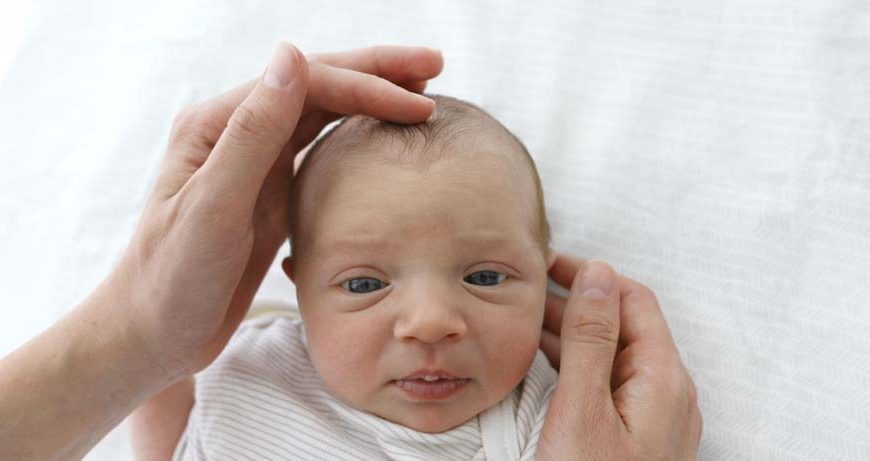Cradle Cap in Newborns: Causes, Symptoms, and Treatment
A new baby is a big occasion that comes with a variety of joys and duties for new parents. The most important of these duties is to make sure the infant is healthy and safe. Even with the most outstanding care, newborns can still acquire a number of skin issues that could worry parents. Cradle cap, also known as infantile seborrheic dermatitis in medical terminology, is one such prevalent ailment. We will examine what cradle cap is, its causes, warning signs, and potent therapies for the ailment in this extensive guide.
What is a Cradle Cap?
A benign skin disease known as “cradle cap,” it is most common in newborns’ first few months of life. On the baby’s scalp, it manifests as yellowish or brownish spots that are frequently accompanied by flaky, greasy, or crusty skin. Although cradle caps in adults may resemble dandruff, it is a unique issue that has to be well understood and managed.
Causes of Cradle Cap:
To properly treat and prevent cradle caps, it is crucial to comprehend their underlying causes. Although the precise reason is not known with certainty, a number of things are thought to have a role in its emergence:
- Overactive Sebaceous Glands: Newborns have more active sebaceous glands than older kids or adults do. This overindulgent behavior may cause a deposit of sebum, an oily material, on the baby’s scalp, giving the cradle cap its recognisable greasy look.
- Fungal Involvement: On the surface of the skin, Malassezia, a form of yeast, is frequently discovered. This yeast may occasionally multiply and aid in the development of cradle caps.
- Maternal Hormones: The placenta allows the mother’s hormones to reach the developing fetus during pregnancy. These hormones may cause the baby’s sebaceous glands to over excite, which might result in the rapid formation of a cradle cap just after birth.
- Lack of Regular Hair Washing: Infants’ scalps shouldn’t be too scrubbed, but poor washing can lead to an accumulation of oils and skin cells, aggravating the issue.
Signs and Symptoms:
It is essential to recognise the symptoms for early intervention and management of cradle caps. Here are some typical signs and symptoms of cradle cap:
- Patchy, Greasy Scalp: The appearance of oily, yellow or brown spots on the baby’s scalp is the most obvious symptom. These patches may come in a variety of sizes and come with flaking skin.
- Flaky Skin: Flakes of skin resembling dandruff may be observed on the baby’s scalp, eyebrows, or behind the ears.
- Redness and Irritation: The afflicted region may occasionally seem somewhat inflamed and red. This could happen as a result of the infant touching or scratching the injured region.
- Mild Itching: Although infants are unable to express discomfort vocally, they may show moderate symptoms by stroking or caressing their heads more often.
How to Prevent Cradle Cap in Newborns:
Combining good hygiene habits with tender care is necessary to prevent cradle caps. Parents can take the following steps to lessen the likelihood that their child will acquire a cradle cap:
- Regular Scalp Massages: The normal shedding of skin cells and oil accumulation can both be halted by gently rubbing the baby’s scalp.
- Frequent but Gentle Shampooing: Several times each week, gently wash the baby’s scalp using a moderate, baby-friendly shampoo. Steer clear of strong chemicals that could remove natural oils.
- Brushing Baby’s Hair: To avoid a buildup of oils and skin cells, carefully comb through the baby’s hair using a soft baby brush.
- Maintaining Hydration: Making sure the infant drinks enough water might assist in controlling the sebaceous glands’ activity.
- Choosing the Right Products: Choose infant care items that don’t include any abrasive chemicals, scents, or colors that can harm the baby’s delicate skin.
How Long Does Cradle Cap Last?
How long cradle caps will last is a prevalent worry among parents. Each baby’s cradle cap will last for a different amount of time. The cradle cap often goes away by itself in most cases within a few months, generally by the time the child turns one. However, certain situations could last a little while longer. It’s crucial to remember that cradle cap is a transient ailment and often does not bother the infant.
Cradle Cap Treatment for Babies:
Although cradle cap usually goes away on its own, there are certain efficient therapies that can quicken the process and provide the infant relief:
- Regular Shampooing: As was already said, washing the scalp with a gentle baby shampoo a few times each week helps maintain it clean and stop the development of oils and skin cells.
- Applying Baby Oil: A tiny quantity of baby oil will help soften the scales, making them more straightforward to remove while washing by gently rubbing it over the troublesome region.
- Using Medicated Shampoos: A pediatrician could suggest an over-the-counter medicinal shampoo with active components like salicylic acid or ketoconazole in more severe instances. However, it would be best to speak with a medical practitioner before using such items on a newborn.
- Avoid Scratching: Preventing the infant from scratching the afflicted region is vital since the cradle cap can occasionally cause moderate irritation. Trimming the baby’s nails can aid with this.
- Consulting a Pediatrician: A pediatrician should be consulted if the cradle cap continues, worsens, or raises any concerns. They can advise the best line of action, and they can also rule out any underlying issues.
Even while a cradle cap is a typical occurrence in babies, it might worry parents. However, parents may confidently manage this ailment if they are well-informed about its causes, symptoms, and therapies. Parents may safeguard their baby’s skin health and general well-being by using proper hygiene practices, picking mild products, and asking for advice from healthcare specialists when necessary. Keep in mind that the cradle cap is a temporary stage in the parenting experience and may be efficiently treated with caution and patience.














